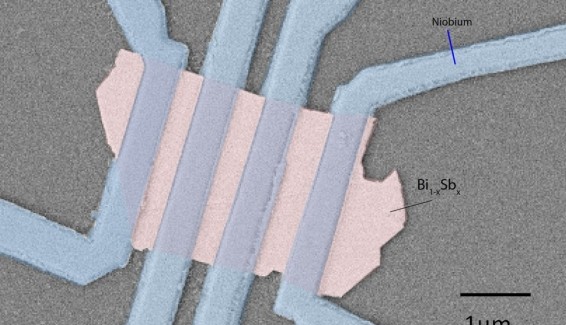‘Impossible’ superconduction
on

The special properties of ‘topological materials’ generally take place at their surface. These materials, for example insulators that nevertheless conduct at their surface, have created high expectations. Researchers from the University of Twente and the University of Amsterdam now demonstrate a new characteristic: the non-superconducting bismuth can nevertheless conduct current without loss. And this super conductivity does not only occur at the surface, but also inside the topological material. That makes this characteristic more robust and less sensitive. The research has been published in Nature Materials.
Topotronics and spintronics
The interest in topological materials has been great for a number of years. Even new terms like topotronics and spintronics have been introduced. The materials receive their special properties by 'playing' with the order of the energy levels: the topology. By 'twisting' these energy levels, a material that does not normally conduct electricity can nevertheless become a conductor at the surface. This not only affects the movements of the electrons, but also their 'spin' – the direction of rotation in which the electrons 'twirl'.
The research shows a clear relationship between the direction of movement and the spin. Thanks to this property a non-superconducting material can nevertheless conduct a current in which Majorana ‘quasi particles’ play an important role. And then not only at its surface: the topological property has also been demonstrated in the bulk of the material. That makes the effect more robust and less sensitive to, for example, noise or pollution.
Semimetal
The material that is used for this, bismuth to which a small amount of antimony has been added, has already demonstrated surprising characteristics and has become a kind of model material for electronic properties. Because bismuth has very few electrons available for conducting current, it can hardly be considered a metal and is therefore sometimes called a 'semimetal'. But the electrons do behave like particles moving at the speed of light.
More than 2D materials
For new types of electronics, also, for example, those based on graphene, the initial starting points are often 2D materials. The newly discovered property indicates that this limitation is not necessarily there: a 'topological quantum computer' could also operate in 3D.
The research was carried out be the group Quantum Transport in Matter, which is part of the MESA+ Institute for Nanotechnology of the UT, in collaboration with researchers from the Van der Waals – Zeeman Institute at the University of Amsterdam. It falls within the UT research theme Shaping our world with smart materials.



Discussion (0 comments)